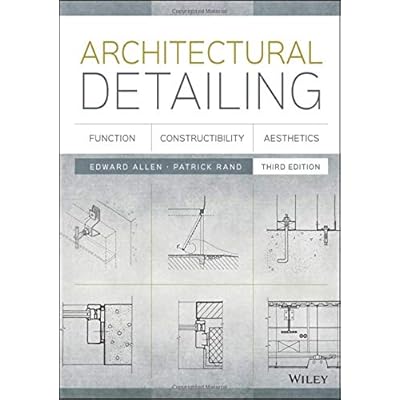Architectural Detailing: Function, Constructibility, Aesthetics, 3rd Edition
Category: Books,Arts & Photography,Architecture
Architectural Detailing: Function, Constructibility, Aesthetics, 3rd Edition Details
Review "...this book presents the drawings alongside a clear description of the function of each individual element. This book would be valuable for anyone who wants to learn how and why things are built, rather than just copying some random detail from a google image search."–East-West News Service, May 2016 Read more From the Back Cover THE CLASSIC DETAILING TEXT, UPDATED WITH THE LATEST DEVELOPMENTS IN PRACTICE AND CODES Architectural Detailing is the go-to text for learning to design details that perform well and look great. Systematically laying out the principles of quality architectural detailing in a highly visual format, this book demonstrates the proper integration of appropriate detailing into ambitious designs, not just safe ones. This new third edition has been updated to include information on new materials, assemblies, and construction methods, and employs recently built works in order to extract underlying principles that can serve as a basis for new patterns. While primarily US-centric in regulatory matters, the text is fully aligned with International Building Codes, and touches on other jurisdictions and geographical settings to provide a well-rounded reference on architectural detailing. Understand detailing patterns related to function, constructibility, and aesthetics Learn how detailing patterns are applied during the design process Follow along with the detailing process of wood, concrete, and brick veneer buildings Apply detailing principles and patterns through hands-on exercises With comprehensive coverage and over 500 illustrations, Architectural Detailing is the most current and useful reference to guide designers through the process of architectural detailing. Read more See all Editorial Reviews

Reviews
Excellent! This book will teach you how to fish. The primary use for me has been to establish a framework for detailing future projects - giving me the "why" and "how" of a WIDE variety of detailing patterns rather than the what. It provides a set of principles in support of detailing projects for protection from water, graceful aging, using the minimum number of parts, etc. etc. etc. etc., and then lets the architect do what architects do best - create meaningful solutions that both accomplish their purpose and reinforce the essence of the project. It goes so far beyond providing cut-and-pasteable solutions.The "patterns" developed in the book are rich and diverse. Although some patterns are essential for nearly all details of a certain type (i.e. removing water from a wall), many are just good ideas. They encourage the architect to create a "hierarchy of values" for their details and apply the patterns that are most relevant to each detail according to that hierarchy. I could even see an architect explaining how she/he is planning to address a client's needs by pointing to particular detailing patterns that she/he will use throughout the project to ensure quality/efficiency.By teaching us how and why to fish rather than providing a list of currently popular fish, this book is certain to have a long and useful life. I have no doubts that this will be the definitive architectural detailing text of its kind for both students and new and old professionals for many, many years to come.




